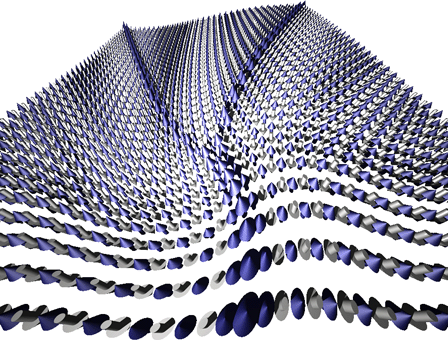| Mott Transition | Mott Physics | Frustrated Magnet | Spin Chain | Metallic Ferromagnetism | Magnetic Transition | Theoretical Approaches |
 In a conventional magnet with a magnetic long-range order, the quasiparticle defined as quantum fluctuations around the magnetic long-range order (magnon) is known to well explain the magnetic excitaion. However, in magnets with competing (frustrating) interactions, disordered ground state (spin liquid state) might be realized, where the magnon does not necessarily appear because there is no magnetic long-range order. Because the magnon can be regarded as a single-spin-flip from the ordered ground state, it carries the magnetization Sz = +1/2 - (-1/2) = 1. In a spin-1/2 antiferromagnetic chain, it is known that magnetic excitations can be well expained in terms of a quasiparticle (spinon) carrying the magnetization Sz = 1/2, which can be regarded as a domain wall split (fractionalized) from the magnon. Even in 2D, possilibities of spin liquids and quasiparticles carrying fractional magnetization have been suggested in strongly frustrated antiferromagnets. In particular, the anisotropic triangular antiferromagnet Cs2CuCl4 has attracted much attention. This material shows power-law behavior in the dynamical structure like in 1D even though it shows 2D dispersion relations. To explain the experimental resutls, various theoretical proposals based on 2D spinons have been made. However, because no theory could explain all the anomalous features observed in this material in a unified manner, the puzzle remained unsolved.
In a conventional magnet with a magnetic long-range order, the quasiparticle defined as quantum fluctuations around the magnetic long-range order (magnon) is known to well explain the magnetic excitaion. However, in magnets with competing (frustrating) interactions, disordered ground state (spin liquid state) might be realized, where the magnon does not necessarily appear because there is no magnetic long-range order. Because the magnon can be regarded as a single-spin-flip from the ordered ground state, it carries the magnetization Sz = +1/2 - (-1/2) = 1. In a spin-1/2 antiferromagnetic chain, it is known that magnetic excitations can be well expained in terms of a quasiparticle (spinon) carrying the magnetization Sz = 1/2, which can be regarded as a domain wall split (fractionalized) from the magnon. Even in 2D, possilibities of spin liquids and quasiparticles carrying fractional magnetization have been suggested in strongly frustrated antiferromagnets. In particular, the anisotropic triangular antiferromagnet Cs2CuCl4 has attracted much attention. This material shows power-law behavior in the dynamical structure like in 1D even though it shows 2D dispersion relations. To explain the experimental resutls, various theoretical proposals based on 2D spinons have been made. However, because no theory could explain all the anomalous features observed in this material in a unified manner, the puzzle remained unsolved.
 Quasiparticle in zero field (triplon) [1]
Quasiparticle in zero field (triplon) [1]
 Quasiparticles in a magnetic field (bound states of 1D quasiparticles in a magnetic field) [2]
Quasiparticles in a magnetic field (bound states of 1D quasiparticles in a magnetic field) [2](1) Multi-particle crossover The dispersion relation of the conventional magnon changes continuously as the magnetic field increases, leading to that of the magnon above the saturation field. In contrast, in the QP picture of bound states of 1D QP's, dominant QP's in the low-field regime gradually disappear as the magnetic field increases. Instead, QP's that emerge in a magnetic field gains spectral weights, leading to the magnon above the saturation field. Namely, dominant QP's in low fields are not continuously connected those in high fields, in contrast with the conventional magnon.
(2) Spin-density-wave-type incommensurate order In spin-wave theory, magnetic orders in a magnetic field are usually due to the fluctuations in the plane perpendicular to the magnetic field (XY-type), whose wavevector little changes in a magnetic field. In contrast, in the QP picture of bound states of 1D QP's, the spin-density-wave(SDW)-type incommensurate order occurs at the wavevector which signaficantly deviates from that of zero field as the magnetic field increases (the deviation is proportional to the magnetization).
(3) High-energy mode A QP of bound states of 1D QP's in a magnetic field has an energy gap. This QP originates from 2-string solutions of a 1D chain. There is no corresponding mode in linear spin-wave theory.
QP's of bound states of 1D QP's can be regarded as collective modes induced from a 1D spin liquid, whose mechanism is analogous to plasmoms or zero-sound modes in a Fermi liquid. However, it should be noted that the QP's are not collective modes of electrons but those of QP's in a 1D spin liquid (spinons, psinons, anti-psinons, QP for a 2-string). Thus, we may call them QP's of an anisotropic-2D spin liquid. The validity of the QP's in anisotropic-2D antiferromagnets has been confirmed, by quantitatively explaining the experimental results observed in Cs2CuCl4 in a magnetic field, such as the magnetization curve, dispersion relation above the saturation field, incommensurate order whose wavevector changes in proportional to the magnetization, and peak potisions and line shapes of the dynamical structure factor in a magnetic field, in a unified manner [2].
[Related paper]
-
"Spinons and triplons in spatially anisotropic frustrated antiferromagnets",
Masanori Kohno, Oleg A. Starykh, and Leon Balents,
Nature Physics 3 pp.790-795 (2007).
(This paper made the cover of Nature Physics Vol.3 No.11.) -
"Quasiparticles of Spatially Anisotropic Triangular Antiferromagnets in a Magnetic Field",
Masanori Kohno,
Physical Review Letters 103, 197203 (2009).